TLSO (Thoracolumbar sacral orthosis)
What is a Brace and why do I need it?
A Spinal brace is a device that is worn to limit the movement of the spine. It can be used to help the healing process after spinal fractures and can also be used to help support the spine following surgery. By limiting the movement of the spine the brace can help prevent further injury and can help reduce pain.
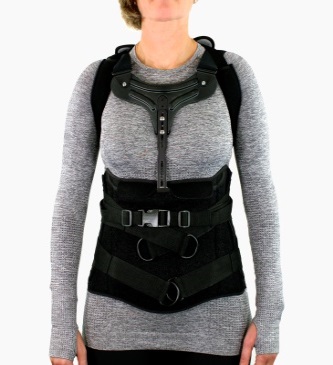
How long will I need it?
The specific time that you are required to wear the brace will be decided by the consultant in charge of your care; it can range depending on the type of fracture, the quality of your bone (for example if you have osteoporosis your bones may take longer to heal) and your compliance. Unless you are told otherwise the brace should be worn when sitting up, walking around and being upright. You do not need to wear the brace in bed. It is important to remove the brace at night to give your skin time to recover from the pressure of wearing it during the day.
|
Consultant: |
|
|
Reason for TLSO brace: |
|
|
Duration required and instructions:
|
You need to apply and remove your brace in: Lying / Sitting. (Delete as appropriate) |
|
TLSO fitted by: |
|
|
TLSO manufacturer /size: |
|
|
Date fitted: |
|
|
Review date/plan:
|
|
How should the Brace fit?
One of the spinal team will measure and fit the brace initially to ensure it is the correct fit for your size and shape. Depending on your injury you may have to apply and remove your brace in a lying or sitting position.
You will be taught how to put your brace on and off before you leave the hospital. We can also teach family/ friends or community support if you are unable to do this independently.
The brace should be tight but comfortable, it should not restrict your breathing although you may feel uncomfortable after a big meal so it is advised to eat little and often.
The brace should look central and level so not twisted or uneven. The main body of the brace should be low over your hips but not restricting you from sitting down.
It should not be loose, if it is riding up or moving then it is likely to not be tight enough, this may result in rubbing of the skin and increased pain due to lack of support to the broken bone.
Please seek medical advice if:
- The brace becomes damaged.
- The skin under the brace looks damaged, sore or has broken down.
- The brace has now become poorly fitting.
- You develop any new pain, numbness or weakness in your legs or numbness of your bottom/ genitalia.
- You develop difficulties with your bladder or bowel control.
Applying your brace
Once fitted if you only open one side of the brace when removing it, it will make it much easier to reapply when you are ready and ensure it fits you correctly.
Option 1 - Lying: Independently
- Lying on your back bend your knees and place feet flat on the bed
- Have the brace open on the bed next to you, lift your bottom and slide the back of the brace under your back.
- Position the brace so the bottom of the brace is in line with the top of your buttocks.
- Check the brace feels central not too far to one side or the other.
Option 2 - Lying: With assistance of 1 person.
- The patient should roll onto their side;
- The person assisting should:
- Position the back of the brace over the back with the bottom of the brace just above the buttocks.
- Holding the brace in place get the patient to roll back onto the brace.
- Check the brace is positioned central to your back by feeling the edges of the back panel either side of the body.
Option 3 - Sitting:
- Roll from lying onto your side and push up into sitting over the edge of the bed keeping your spine straight and avoiding twisting.
- Position the back of your brace behind you.
- Feel the edges of the back panel and ensure it feels central.
- Make sure the bottom of the brace is sitting just above your buttocks.
Following the starting points above, the rest of the application is the same as follows:
- Fold the front panel around your tummy, attach the long bar of vertical Velcro from the back panel onto the edge of the front panel.
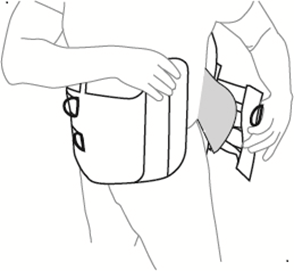
- Locate the 2 horizontal Velcro straps, tighten one at a time by pulling the strap out to the side and fold over and stick to the front panel. Repeat with the second strap.

- Locate the shoulder straps-there will be four altogether – two each side.
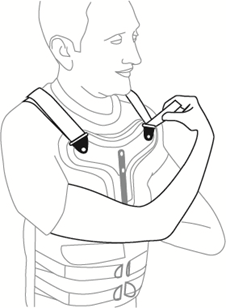
Two will be soft stretchy material – locate these first - these sit over the top of your shoulder like a dungarees strap and thread through the loop attached to the chest plate. Fold the strap back and attach it to itself using a piece of Velcro. These straps should fit flat against the shoulders without gapping.
- In sitting locate the second set of shoulder straps – these are more rigid cord straps. Pass the straps around the front of your shoulders then under your armpit – like a backpack strap. There is a padded section which is for comfort and fits under your armpit.

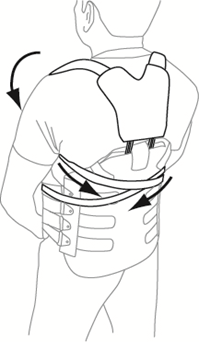
Next pass the straps behind your back crossing them over each other and wrapping them around the front of your tummy, the two straps then click together.
This strap reinforces posture therefore should be tight but comfortable, if you find the straps are digging into your armpits, try to re-adjust your posture or if you are tired have a lie down and take the brace off for a break.
Removing your brace
- In sitting unclip the buckle located on your tummy to release the shoulder straps, remove the straps from under your shoulders and place them out of the way.
- Undo the soft shoulder straps by unfastening the Velcro and threading the straps out from the chest plate loops.
- (At this point return to lying if you have been told to apply and remove your brace in lying and continue.)
- Undo ONE side of the brace by releasing the two horizontal straps and then the vertical bar of Velcro to release the main body of the brace, open it like a book and remove. If you are lying, do this via rolling off it or lifting your bottom and sliding the brace out from under you.
Chest Plate
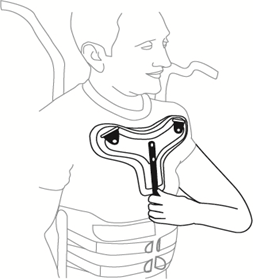
The chest plate will be adjusted to fit comfortably against the upper part of your breastbone. If you find it is touching your neck then it is too high.
Trouble shooting if your chest plate is sitting too high:
- Check and adjust your posture - are you slouching onto it?
- Check has the brace ridden up? If so, reapply lower over your hips.
Cleaning
If the brace becomes soiled from food etc. then it can be sponged down with soap and water and left to air dry.
The brace increases your temperature and causes perspiration. This build-up of moisture can cause skin to breakdown under the brace. This, in extreme circumstances, can lead to pressure ulcers.
To minimise this risk we recommend you wear a thin layer of clothing underneath your brace and inspect the skin daily. The first sign of pressure is often skin discolouration (redness). www.nhs.uk/conditions/pressure-sores/
If left, these symptoms can blister or open the skin. If redness is an issue we can provide padding, so please do notify us.
Key points to remember
- A thin layer of clothing should be worn between you and the spinal brace to prevent rubbing or sores.
- The spinal brace should be TIGHT but COMFORTABLE.
- If excessive sweating occurs, please remove the spinal brace and rest for short periods lying down – this is especially important if you have a wound from surgery.
- The spinal brace should be kept on at ALL times except when lying flat – you do not need to wear your brace in bed, unless you have been instructed otherwise by your consultant.
- The spinal brace will only limit movement within your back, not eliminate it completely. It is important that you monitor your posture to prevent slouching, and avoid any bending, heavy lifting or twisting.
- Bathing and showering is not permitted unless you are given special instruction from your consultant.
My Recovery
One of the therapy team will come and assess your needs. They will make sure you can move and walk safely in your spinal brace. It is important to keep active by walking daily and building your exercise tolerance, you may be given an individualised exercise program to continue at home by your therapist.
If you are struggling with self-care (eg washing and dressing) please discuss this with your therapist and they will help teach you the best way to manage this during your recovery.
Driving: You are advised not to drive while wearing the TLSO Spinal Brace due to the reduction in movement and the effect this has on accessing your blind spot. It is your responsibility to contact the DVLA and your insurance company to inform them of your injury and to attain advice regarding return to driving.
Discharge and follow up: Your consultant and spinal team will arrange the appropriate follow up with you on discharge. You will return for repeat X-rays and a review appointment where your progress and further management will be discussed.
Will I ever need surgery?
Very occasionally, if conservative measures fail, an operation may be indicated and this will be advised by the specialist team.
Contact details
Spinal Nurse Team: 0151 556 3424 (Monday to Friday 09.00- 17.30)
Therapy Team: 0151 556 3863 (Monday to Friday 08.00-16.00)
Produced in conjunction with:
All images copyright of Beagle Orthopaedic
https://beagleorthopaedic.com/
- Last Updated:01 July 2023
- Review Date:30 July 2025
- Author:Susan Whittam/Spinal Nurse Specialist Team
- Summary:
A Spinal brace is a device that is worn to limit the movement of the spine. It can be used to help the healing process after spinal fractures and can also be used to help support the spine following surgery.